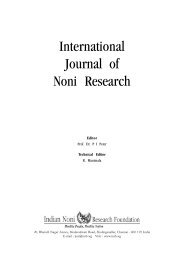International Journal of Noni Research - Noni Family
International Journal of Noni Research - Noni Family
International Journal of Noni Research - Noni Family
You also want an ePaper? Increase the reach of your titles
YUMPU automatically turns print PDFs into web optimized ePapers that Google loves.
D.R. Singh et al. Morinda citrifolia L. – An evergreen plant for diversification in commercial horticulture<br />
Agrotechniques<br />
As the Morinda plants are quite susceptible to root knot nematode, the site<br />
selection should be done carefully in order to avoid those places. It should<br />
contain proper aerated soil with adequate drainage facilities and adequate<br />
light. Although it grows in varied agro climatic and soil conditions it does not<br />
grow well where winds are strong. The proper spacing for Morinda plants<br />
is 4 x 4 m. Plants <strong>of</strong> less than three years <strong>of</strong> age should be pruned after their<br />
first production <strong>of</strong> fruit. Pruning usually reduces the outbreak <strong>of</strong> pests and<br />
diseases. Morinda plants require only limited application <strong>of</strong> fertilizers. A<br />
fertilizer application <strong>of</strong> 10-20-20 kg NPK/ ha will be sufficient. Morinda<br />
plants need moderate irrigation but once they are established fully, they can<br />
withstand drought. Over watering can result in root knot nematode and root<br />
rot (Nelson, 2005). Morinda fruits can be harvested when they change their<br />
colour infestation from green to yellowish green. Usually these stages <strong>of</strong> fruits<br />
are suitable for shipping. For self use or local purpose, fruits can be<br />
harvested when ripe so that the juice can be squeezed easily from it. Fruits<br />
should be harvested 3 years after planting at any stage <strong>of</strong> development<br />
depending on the proposed processing method. Mostly producers prefer<br />
green fruits, where as, the processors prefer mature yellowish green fruit for<br />
processing. <strong>Noni</strong> fruits do not bruise or damage easily and need not be<br />
refrigerated.<br />
Results and discussion<br />
The survey results revealed that due to its hardiness or versatile nature it<br />
is found growing near road side (Location – 11 o 37’03.08”; 92 o 42’<br />
30.2”), near sewage drain (11 o 40’6.3”; 92 o 44’ 15.9”), under shaded<br />
conditions (11 o 40’13.5; 92 o 43’56.2”), in hill top (11 o 35’50.7’; 92 o<br />
43’56.2”), near sea shore (11 o 35’37.6”; 92 o 36’38.1”), in sea water<br />
inundated lands (11 o 36’42.6”; 92 o 40’47.3”), in jungle areas (11 o 40’<br />
27.8”; 92 o 43’ 36”38”), and in various other locations like Ross Island,<br />
which was erstwhile capital <strong>of</strong> Port Blair during the reign <strong>of</strong> British, where<br />
Morinda tree was found to be growing even in tree trunks, in old damaged<br />
buildings, in symbiotic association with Ficus plants etc.<br />
Effect <strong>of</strong> gibberlic acid as growth regulator<br />
Various seed germination studies were undertaken by this institute and the<br />
results revealed that GA at 800 ppm followed by 1000 and 1200 ppm<br />
induced significantly higher percentage <strong>of</strong> germination (91.06, 87.9 and<br />
80.4% respectively) against water treatment (56.4%). Results further elucidated<br />
Intl. J. <strong>Noni</strong> Res. 2007, 2(1-2) 50








